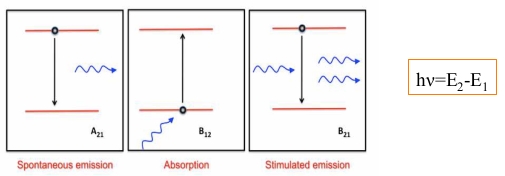序
经典辐射理论只适用于光子能量远小于辐射粒子动能的情况$h\nu \ll E$,但天体物理中很多辐射并不满足这个条件。
对于$h\nu \sim E$这类辐射,严格来说应该用量子电动力学(QED)来描述,那就对于刚入坑的人(我)来说不太友好。
所以有没有一种折中的办法呢?当然是有的。
天体物理中的大多数辐射现象都可以用一个叫“半经典的量子辐射”的理论处理。
那半经典是个啥?
总的来说大概就是只考虑带电粒子运动的量子化;而辐射场不量子化,仍当作经典电磁场处理。
不同于经典辐射理论的先求辐射场各点场强(E,B),而是将辐射看作带电粒子的能级跃迁过程。
为求辐射的基本问题:功率、角分布、谱分布、偏振等
核心问题即求量子态之间跃迁概率。
Einstein Coefficients 爱因斯坦系数
爱因斯坦系数描述粒子的发射与吸收性质, 包括:

自发发射系数 $\mathrm{A}_{21}$ :单位时间内粒子从能级 2 跃迁到能级 1、发射一个频率为 $v$ 的光子的概率 $h v=E_{2}-E_{1}$ (the transition probability per unit time for spontaneous emission at $h v=E_{2}-E_{1}$ )
吸收系数 $\mathrm{B}_{12}$ : 单位时间内粒子吸收一个频率为 $v$ 的光子从能级1 跃迁到能级 2 的概率 ) 为 $p_a=\mathrm{B}_{12} \mathrm{~J}_{\mathrm{v}}\left(B_{12} J_{v}\right.$ describes the transition probability per unit time for absorption)
其中 $J_{\nu}=(1 / 4 \pi) \int I_{\nu} d \Omega$
$I_v$为辐射强度,$\frac{d \Omega}{4\pi}$是越迁的光子沿某立体角元传播,占全天的比例
受激发射系数 $\mathrm{B}_{21}$ :受 $J_{v}$ 的刺激(扰动), 单位时间内粒子从能级2跃迁到能 级I并辐射一个频率为 $v$ 的光子的概率) 为 $p_i=\mathrm{B}_{21} \mathrm{J_v}$
$\left(B_{2 l} J_{v}\right.$ describes the transition probability per unit time for stimulated emission)
由热力学平衡时光子数守恒(n1和n2为位于能级1、2的光子数),发射数=吸收数:
在热平衡时, 各能级原子相对数目由Maxwell-Boltzmann公式给出:
其中N为总粒子数, $Z=\sum_{i} g_{i} e^{-E_{l} / k T}$
where $g_{1}$ and $g_{2}$ are the statistical weights (统计权重) of the levels 1 and $2 .$
Thus, $\quad J_{\nu}=\frac{A_{21} / B_{21}}{\left(g_{1} B_{12} / g_{2} B_{21}\right) e^{h \nu / k T}-1}$
在处于热力学平衡的黑体内部或封闭系统内, $J_{v}=B_{v}$ (普朗克函数),
利用 $J_{\nu}=\frac{A_{21} / B_{21}}{\left(g_{1} B_{12} / g_{2} B_{21}\right) e^{h \nu / k T}-1} \quad$ 得到两个重要公式:
$\begin{aligned} g_{1} B_{12} &=g_{2} B_{21} \\ A_{21} &=\frac{2 h \nu^{3}}{c^{2}} B_{21} \end{aligned} \quad\left(\begin{array}{l}\text { 注意: 此关系在这里是在热平衡导 } \\ \text { 出, 对非热平衡也适应, 因为它反 } \\ \text { 映的是原子过程, 与温度无关 }\end{array}\right)$
The relations between the Einstein coefficients are called Einstein relations, they imply that we need to know only one of them to find the others. They have no reference to the temperature (unlike Kirchhoff’law), thus it holds whether or not the atoms are in LTE.





